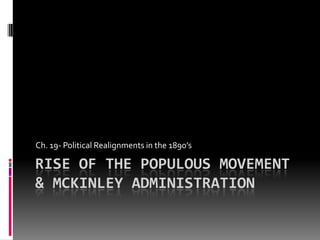Rise of the_populous_movement_&_mc_kinley_administration[1] 123
- 1. Rise of the Populous Movement & McKinley Administration Ch. 19- Political Realignments in the 1890¡¯s
- 2. ObjectivesUnderstand the impact made by the famers joining the Alliance in the 1890¡¯sKnow the role of the Farmers¡¯ AllianceKnow who was in the People¡¯s Party and what they did and accomplished. Importance of the Election of 1900Analyze McKinley¡¯s work in office
- 3. Rise of the Populous MovementThe fast- growing movement among farmers that soon came to be known as populism.
- 4. In Summer of 1890 many farmers came together at campgrounds to discuss common problems: fear of drought, mortgages, and low crop prices.
- 5. Came in thousands and listened to recruiters from the National Farmers¡¯ Alliance and Industrial Union.
- 7. Caught their attention, started joining at the rate of 1,000.
- 8. -Kansas Alliance had 130,000 in the year of 1890.The Farm ProblemAmerican Farmers were not too thrilled about declining prices for their products, rising railroad rates for shipping them, and heavy mortgages.
- 9. Farmers Products: Due to the industry becoming more popular, agriculture produces low profits. -Although the farmers received less for their crops, their purchasing power increased.Railroad Rates: Problem with farmers complaint over rising railroad rates: They fell during these years, benefiting shippers of all products.
- 10. Mortgages: This problem was common between farmers because they mortgaged their property to expand their holdings or buy new farm machinery.-Often short, with a term of four years or less, afterwards farmers would negotiate new rates, and new machinery would enable them to triple their production and increase their income.
- 11. Books of WarningFarmers became ¡°hayseeds¡±, word first appeared in 1889, and they watched their offspring leave for city lights and new careers -Books were written to warn against this move, but still the children went.The Spider and the Fly: or, Tricks, Traps, and Pitfalls of City Life by One Who Knows (1873) -Most famous, Hamlin Garland¡¯s Son of the Middle Border (1890) and Main- Traveled Roads (1891), which described the dullness of farm life.
- 12. Fast- Growing Farmers¡¯ AllianceIn place of the grange (originally a social organization for farmers) sprang up two major farmer organizations. Northwestern Alliance & Southern Alliance
- 13. The Southern Alliance- Began in Texas (1875). Members: farmers who were fed up with crop liens, depleted land, and share cropping and (natural friends) ,country doctors, school teachers, preachers, and mechanics.
- 14. Projects: Published newspapers and alliance material to local newspapers. -Most massive organization driven by citizen institution.Est. cooperate grain elevators, marketing association, retail stores. Were all designed to bring farmers together to make greater profits, (all short lived).
- 15. In 1889, the Southern Alliance changed its¡¯ name to National Farmers Alliance and Industrial Union and persuaded North Dakota, South Dakota, and Kansas Alliances to join, dominating the Alliance movement A New AllianceColored Farmers National Alliance &Cooperative UnionEnlisted black farmers in the South, 1891. Black cotton pickers struck for higher wages.An abortive strike ended the Colored Famers¡¯ Alliance
- 16. Northern AllianceLocated on the plains, a smaller organization formed in 1880.Same objectives as Southern Alliance but disagreed with secrecy, centralized control, and separate organizations for blacks.The alliance turned early to politics. -West made own party.Southern Alliance resisted the idea of new party for fear it might divide the white vote, thus under cutting white supremacy.
- 17. Alliance LeadersThomas E. Watson- Georgia born, talented orator, and organizer, urged Georgia farmers of all colors to unite against oppressors.Leonidas L. Polk- President of NFA, believed in scientific farming and cooperative action.Jeremiah Simpson- Kansas native, reflective, well read. Most able leader, he pushed for major social and economic change.Mary E. Lease- Kansas native, helped head a movement remarkably open to female leadership. Captivating speaker.
- 18. The People¡¯s PartyNorthern Alliance leaders urged the formation of the third party to promote reform. The Party called upon the federal government to buffer economic depressions, regulate banks and corporations, and help farmers who were suffering hard times.In 1892, a convention in Omaha, Nebraska, formed a new people¡¯s, or populous party.Southern Alliance leaders joined being fed up with democrats, which they believed exploited them.Many of the delegates had planned to nominate Leonidas L. Polk for president but he died suddenly and they turned to James B. Weaver- Former congressman, union army general, and third party candidate.The Platform- Adopted many of the Ocala demands.The party elected several members to Congress, three governors, and hundreds of minor officials and legislators, nearly all in the Midwest. In the South, they challenged white supremacy by forming coalitions with black farmers in common cause.
- 20. The election of 1892James B. Weaver won 1,029,000 votes, the first third-party presidential candidate ever to attract more than a million.Despite Populist Victories the election brought disappointment.Southern Democrats used intimidation, fraud, and manipulation to hold down populist votes.Weaver lost heavily in urban areas and he also failed to win over most farmers.Many voters tended to realign with democrats. ( Populists platform on silver and other issues had little appeal among city dwellers or factory workers.1892, Farmers Alliance membership dropped for second year in a row, and the peoples party was broken.With the defeat of Democratic presidential candidate William Jennings Bryan and with the Democrats successfully launching white unity campaigns in the South, the Populists gradually disappeared as a political force. The alliance was one of the most powerful protest movements in American history. It attempted to solve specific economic problems while at the same time advancing a larger vision of harmony & community in which people were rewarded for what they produced.












